Next: Small-Signal Model and H Up: ch4 Previous: AC Signal Amplification
As shown before, the DC operating point of a transistor amplification circuit
needs to be set up properly (in the middle of the linear region) to avoid
signal distortion. We now consider how the operating point is determined by
the biasing circuit, in terms of 


Fixed Biasing
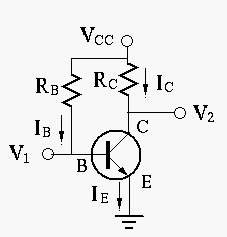
By properly setting the voltage 



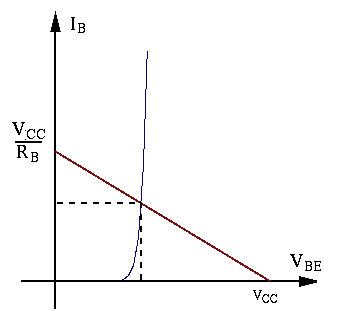
The DC operating point in terms of 

 |
(29) |
If the transistor is in linear region, then
 |
(30) |
 |
(31) |
 and
and  depend on
depend on  , which may differ for
different transistors and change depending on the temperatures
the operating point may be unstable and inconsistent.
, which may differ for
different transistors and change depending on the temperatures
the operating point may be unstable and inconsistent.
Example 1
In the fixed biasing transistor circuit shown above,







 |
(32) |
 to be in the middle of the
load line, we need to have
to be in the middle of the
load line, we need to have
 i.e. i.e. |
(33) |
 to be twice of
to be twice of
 at the DC operating point:
at the DC operating point:
 i.e. i.e. |
(34) |
 |
(35) |
Example 2:
In the same circuit above,





The load line



 |
(36) |
 values:
values:
 |
(37) |
To minimize distortion, the DC operating point needs to be in the
middle of the load line at

 , too close to cutoff region.
, too close to cutoff region.
 , in the middle of linear region as desired.
, in the middle of linear region as desired.
 , too close to the saturation region.
, too close to the saturation region.
The DC operating point of this fixed biasing circuit is not
completely determined by the parameters of the circuit such as
the resistors, as it is also directly affected by factors such
as 
Self-Biasing
To correct the problem above, the self-biasing circuit shown below
can be used to decrease the effect of changing 

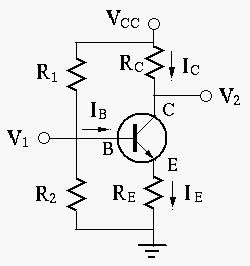
Qualitatively, an increased 

 |
(38) |
Quantitatively, we can further carry out analysis of the circuit:
 and
and  are small so that the
current
are small so that the
current  through
through  is much larger than the base current
is much larger than the base current
 i.e.,
i.e.,
 , then the basis voltage
, then the basis voltage  can be
approximated to be (voltage divider):
can be
approximated to be (voltage divider):
 |
(39) |
 |
(40) |
 , we get
, we get
 |
(41) |
 is independent of
is independent of  , as it is completely
determined by
, as it is completely
determined by  ,
,  , and
, and  , as well as
, as well as  .
.
 is not satisfied, the method
above is no longer valid. In this case, we can use Thevenin's theorem
to replace the base circuit by an open circuit voltage
is not satisfied, the method
above is no longer valid. In this case, we can use Thevenin's theorem
to replace the base circuit by an open circuit voltage  (already found above), in series with the internal resistance
(already found above), in series with the internal resistance  :
:
 |
(42) |
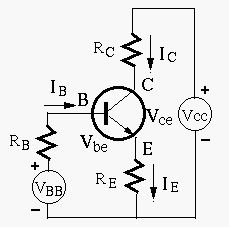
Applying KVL to the base loop we get
 |
(43) |
 , we get:
, we get:
 and and |
(44) |
 is not too small (strong negative feedback effect) and
is not too small (strong negative feedback effect) and
 is not too large (approximately a voltage divider),
so that
is not too large (approximately a voltage divider),
so that
 (e.g.,
(e.g.,
 even for a small
even for a small  ), then
), then  can be approximated as
can be approximated as
 |
(45) |
 , and thereby
, and thereby  and the DC operating point,
is determined only by the resistors of the circuit, independent of the
and the DC operating point,
is determined only by the resistors of the circuit, independent of the
 . Comparing this with fixed biasing with
. Comparing this with fixed biasing with
 directly proportional to
directly proportional to  ,
the self-biasing circuit has a much more stable operating point.
,
the self-biasing circuit has a much more stable operating point.
For this approximation above to be valid, we desire to have smaller





Example 3:
In the circuit of self-biasing,






 |
(46) |
 and
and
 (short-circuit current)
(short-circuit current)
 and
and
 (open-circuit voltage)
(open-circuit voltage)
To minimize distortion, the desired operating point should be in the
middle of the load line at


 :
:
 |
 |
 |
|
 |
 |
 |
|
 |
 |
 |
|
 |
 |
 |
|
 |
 |
 |
|
 |
 |
 |
(47) |
 |
 |
 |
|
 |
 |
 |
|
 |
 |
 |
|
 |
 |
 |
|
 |
 |
 |
|
 |
 |
 |
(48) |
 values
can be found to be:
values
can be found to be:
 |
(49) |
We see that in all three cases,


Example 4
In a self-biasing transistor circuit,





We first convert the base circuit into its Thevenin's equivalent voltage source composed of
 |
(50) |
 |
(51) |
 |
(52) |
 , and solving the equation we
get
, and solving the equation we
get
 .
.
Example 5
The circuit below shows yet another way to introduce feedback to stablize the DC operating point.
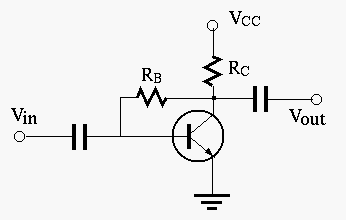
 connecting the collector to the base forms
a feedback from the output
connecting the collector to the base forms
a feedback from the output  to
to  as well as providing
the forward baising needed for the base-emitter PN junction:
as well as providing
the forward baising needed for the base-emitter PN junction:
 |
(53) |
 |
(54) |
 we get
we get
 |
(55) |
 |
(56) |
 (strong negative feedback),
then
(strong negative feedback),
then
 , independent of
, independent of  .
Although typically
.
Although typically  is significantly greater than
is significantly greater than  ,
the negative feedback still has the tendency to reduce the affect
of varying
,
the negative feedback still has the tendency to reduce the affect
of varying  and thereby stablize the DC operating opint.
and thereby stablize the DC operating opint.
 ,
,  , and a desired
, and a desired  , find
, find
 and
and  so that the DC operating point is in the middle of
the linear region.
so that the DC operating point is in the middle of
the linear region.
For the DC operating point with 



 |
 |
 |
|
 |
 |
 |
(57) |
 |
(58) |
 |
(59) |
 values, which
are all approximately in the middle of the linear region:
values, which
are all approximately in the middle of the linear region:
 |
(60) |
As discussed above, to avoid distortion of the AC signal,
we desire that the DC operating point is in the middle of
the linear region of the output characterisc, i.e.,



 |
 |
 |
|
 |
 |
 |
(61) |
 , and
, and
 |
(62) |